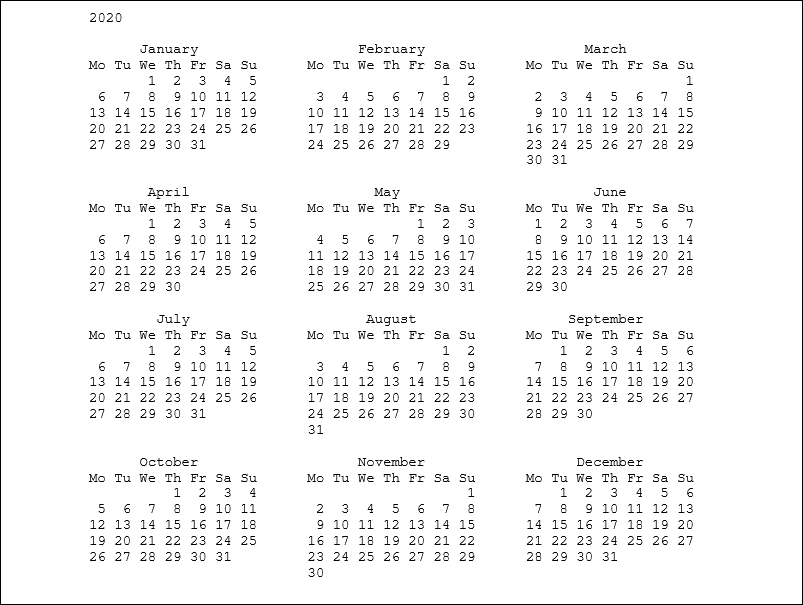Python provides the datetime module work with real dates and times. In real-world applications, we need to work with the date and time. Python enables us to schedule our Python script to run at a particular timing.
In Python, the date is not a data type, but we can work with the date objects by importing the module named with datetime, time, and calendar.
In this section of the tutorial, we will discuss how to work with the date and time objects in Python.
The datetime classes are classified in the six main classes.
- date – It is a naive ideal date. It consists of the year, month, and day as attributes.
- time – It is a perfect time, assuming every day has precisely 24*60*60 seconds. It has hour, minute, second, microsecond, and tzinfo as attributes.
- datetime – It is a grouping of date and time, along with the attributes year, month, day, hour, minute, second, microsecond, and tzinfo.
- timedelta – It represents the difference between two dates, time or datetime instances to microsecond resolution.
- tzinfo – It provides time zone information objects.
- timezone – It is included in the new version of Python. It is the class that implements the tzinfo abstract base class.
Tick
In Python, the time instants are counted since 12 AM, 1st January 1970. The function time() of the module time returns the total number of ticks spent since 12 AM, 1st January 1970. A tick can be seen as the smallest unit to measure the time.
Consider the following example
import time;
#prints the number of ticks spent since 12 AM, 1st January 1970
print(time.time())
Output:
1585928913.6519969
How to get the current time?
The localtime() functions of the time module are used to get the current time tuple. Consider the following example.
Example
import time;
#returns a time tuple
print(time.localtime(time.time()))
Output:
time.struct_time(tm_year=2020, tm_mon=4, tm_mday=3, tm_hour=21, tm_min=21, tm_sec=40, tm_wday=4, tm_yday=94, tm_isdst=0)
Time tuple
The time is treated as the tuple of 9 numbers. Let’s look at the members of the time tuple.
| Index | Attribute | Values |
|---|---|---|
| 0 | Year | 4 digit (for example 2018) |
| 1 | Month | 1 to 12 |
| 2 | Day | 1 to 31 |
| 3 | Hour | 0 to 23 |
| 4 | Minute | 0 to 59 |
| 5 | Second | 0 to 60 |
| 6 | Day of weak | 0 to 6 |
| 7 | Day of year | 1 to 366 |
| 8 | Daylight savings | -1, 0, 1 , or -1 |
Getting formatted time
The time can be formatted by using the asctime() function of the time module. It returns the formatted time for the time tuple being passed.
Example
import time
#returns the formatted time
print(time.asctime(time.localtime(time.time())))
Output:
Tue Dec 18 15:31:39 2018
Python sleep time
The sleep() method of time module is used to stop the execution of the script for a given amount of time. The output will be delayed for the number of seconds provided as the float.
Consider the following example.
Example
import time
for i in range(0,5):
print(i)
#Each element will be printed after 1 second
time.sleep(1)
Output:
0 1 2 3 4
The datetime Module
The datetime module enables us to create the custom date objects, perform various operations on dates like the comparison, etc.
To work with dates as date objects, we have to import the datetime module into the python source code.
Consider the following example to get the datetime object representation for the current time.
Example
import datetime
#returns the current datetime object
print(datetime.datetime.now())
Output:
2020-04-04 13:18:35.252578
Creating date objects
We can create the date objects bypassing the desired date in the datetime constructor for which the date objects are to be created.
Consider the following example.
Example
import datetime
#returns the datetime object for the specified date
print(datetime.datetime(2020,04,04))
Output:
2020-04-04 00:00:00
We can also specify the time along with the date to create the datetime object. Consider the following example.
Example
import datetime
#returns the datetime object for the specified time
print(datetime.datetime(2020,4,4,1,26,40))
Output:
2020-04-04 01:26:40
In the above code, we have passed in datetime() function year, month, day, hour, minute, and millisecond attributes in a sequential manner.
Comparison of two dates
We can compare two dates by using the comparison operators like >, >=, <, and <=.
Consider the following example.
Example
from datetime import datetime as dt
#Compares the time. If the time is in between 8AM and 4PM, then it prints working hours otherwise it prints fun hours
if dt(dt.now().year,dt.now().month,dt.now().day,8)<dt.now()<dt(dt.now().year,dt.now().month,dt.now().day,16):
print("Working hours....")
else:
print("fun hours")
Output:
fun hours
The calendar module
Python provides a calendar object that contains various methods to work with the calendars.
Consider the following example to print the calendar for the last month of 2018.
Example
import calendar;
cal = calendar.month(2020,3)
#printing the calendar of December 2018
print(cal)
Output:
March 2020
Mo Tu We Th Fr Sa Su
1
2 3 4 5 6 7 8
9 10 11 12 13 14 15
16 17 18 19 20 21 22
23 24 25 26 27 28 29
30 31
Printing the calendar of whole year
The prcal() method of calendar module is used to print the calendar of the entire year. The year of which the calendar is to be printed must be passed into this method.
Example
import calendar
#printing the calendar of the year 2019
s = calendar.prcal(2020)
Output:

